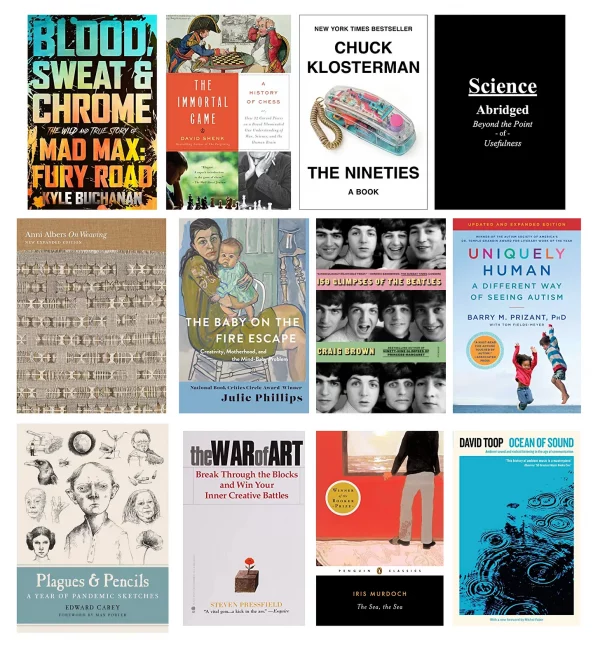
A dozen good books I read this summer (more in my newsletter):
- Kyle Buchanan’s Blood, Sweat & Chrome: The Wild and True Story of Mad Max: Fury Road was really excellent. I’d put it on the shelf with my other favorite moviemaking books, like Sidney Lumet’s Making Movies and Walter Murch’s In The Blink of an Eye. I also enjoyed Aljean Harmetz’s 1977 book, The Making of the Wizard of Oz, which paired really well with the documentary Light & Magic, and Matt Zoller Seitz’s The Wes Anderson Collection, a deluxe art book that covers the filmmaker’s first seven movies and has a bunch of interviews and behind-the-scenes stuff.
- A great surprise of the summer was when my 9-year-old and I started playing chess together. David Shenk’s The Immortal Game: A History of Chess is constructed rather brilliantly, alternating chapters of history with the moves of a famous chess game. A perfect introduction for someone like me. I also loved working through the classic Bobby Fischer Teaches Chess, which has a reallyintriguing design: on the right-side spread of the pages, you’re presented with chess problems and then you turn the page for the answer. When you get to the end of the book, you flip it around and the prompts continue. Very clever, almost like a Choose Your Own Adventure book, and I marvel at how it was laid out without desktop software in the late 60s. (I’d love to know more about that era of paperback publishing — I probably should re-read The Electronic Information Age Paperback.)
- I was a little surprised how much I liked Chuck Klosterman’s The Nineties: A Book. Another heavy dose of nostalgia was Ander Monson’s Predator: A Memoir, A Movie, An Obsession. It made me think a lot about the value of studying something you love in depth.
- I finally finished Iain McGilchrist’s massive, two-volume 1,400+ page book, The Matter With Things. It was a very centrifugal book, which spun me out to books like Mary Midgley’s The Myths We Live By, and got me interested in creative tensions. But for a much funnier take on scientific reductionism, see cartoonist Zach Weinersmith’s very brief book, Science: Abridged Beyond the Point of Uselessness.
- Anni Albers’ On Weaving is a gorgeous, singular book, almost centripetal in force. It inspired me to write about the creative tension of “warp and weft.”
- Julie Phillips’ The Baby on the Fire Escape: Creativity, Motherhood, and the Mind-Baby Problem shot to the top of my list of great books about art and motherhood. Good structure and great sentences.
- My comfort reading is music books, and I loved Craig Brown’s 150 Glimpses of the Beatles. As someone who considers himself a pretty big Beatles fan, I’m surprised how many of these stories I didn’t know, and the ending was just brilliant. God bless books that stick the landing.
- Barry M. Prizant’s Uniquely Human: A Different Way of Seeing Autism is a really helpful and hopeful book — even people with neurotypical kids in their life will get a lot out of it. (The book was written with friend of the newsletter, Tom Fields-Meyer, who also wrote Following Ezra, a memoir about raising his autistic son.)
- Edward Carey’s Plagues and Pencils: A Year of Pandemic Sketches is a collection of Carey’s pandemic drawings, but what really moved me were the mini-essays on drawing and being stuck inside and what it’s like to live in a place you’re ambivalent about living in. (Another good mix of pictures and words: cartoonist Kate Beaton’s memoir, Ducks: Two Years in the Oil Sands. The book is getting a lot of deserved acclaim, but it is driving me a little nuts how people are positioning this as a “serious” work in opposition to her “lighter” cartoons. The thing I most admired about the book was the way Beaton was able to tackle such serious subject matter while keeping the lightness and looseness of her line.)
- I finally read Steven Pressfield’s classic The War of Art, which I avoided for years because I don’t like war metaphors. I enjoyed it, and perhaps paradoxically, I enjoyed it in part because it is so unashamedly macho and Boomer-ish? (For example, at one point Pressfield writes, “Can you stand another Tiger Woods story?” ?) It is a mistake to make too much of generations, but The War of Artmade me think about how many of the classic creativity books were written by baby boomers, like Anne Lamott’s Bird By Bird and Julia Cameron’s The Artist’s Way. (Twyla Tharp’s The Creative Habit, on the other hand, is an outlier. Tharp is from the older “silent generation.”)
- Iris Murdoch’s The Sea, The Sea tested my patience in a way no book has in quite a while. I got swept away at the beginning, and I went through several of the potential reactions, but I was somehow unable to take my own number one piece of reading advice. These are the most maddening books, the ones that get their hooks in you while also torturing you. My final verdict: I would have liked it more if there was less of it!
- I finally finished David Toop’s Ocean of Sound. For a collection of writing about some of my favorite music — Brian Eno, Erik Satie, Sun Ra, Kate Bush, Kraftwerk, Aphex Twin, etc. — it took me quite a while to get through. (I started it in the spring.) Maybe because it’s a non-linear book, very collage-like, it’s probably best digested in snippets. Worth a look, though, especially if you love ambient.
Filed under: my reading year 2022